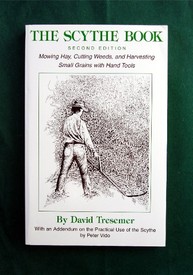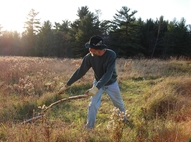 I just read on another website that The Scythe Book by David Tresamer, is still considered the "Bible" for scythe users. If that is true, it is mainly because it's still the only book in print, in the English language. Surprisingly, this book is actually responsible for a lot of confusion with Austrian scythe users. I live in an area with many organic gardeners, and the area is saturated with mail-order scythes and The Scythe Book, Mostly the first edition. When I mention that I sell scythes, and teach scythe workshops, they proudly tell me that they've had a scythe for a long time, and that they already know how to use it, and that they love it. When I ask them what they mow with it, they admit "Oh, I don't use it that much really. Just for weeds, now and then. It works great for that." When I ask them how they sharpen it, they proudly pantomime their interpretation of using a whetstone. When I ask them if they've ever peened their blades, they say " No, I never did figure out how to do that. I probably should." So in other words, they fell in love with the mystique of using an Austrian scythe, but never really learned how to use it effectively, nor how to sharpen it, which resulted in very strenuous mowing. So they "just don't use it that much", because, let's face it, it's too much work that way! While The Scythe Book convinced people that the Austrian scythe was a great improvement over the American-style scythe, the lack of accurate technical knowledge in the original Scythe Book, didn't actually lead people all that much further. The first edition filled people with excitement for the concept and mystique of the "Austrian" scythe, but didn't result in much grass being cut (except, perhaps by heroic effort!). To address the shortcomings of the first edition, Peter Vido wrote an Addendum for the 2nd Edition. This "New Testament", points out the many errors in the technical sections of the "Old Testament", and makes a good attempt at giving those, who seriously desire to master the tool, a more accurate and functional base of knowledge. It explains scythe fit, form, and function, and introduces an innovative style of mowing introduced by Peter Vido. It also attempts to solve the problem of teaching new "Austrian" scythe users how to finally sharpen their blades, by introducing them to the peening jig. But The Scythe Book is now almost 10 years old, and like much published information in this age, it quickly becomes dated. Peter Vido approached the publisher of The Scythe Book , to publish an updated edition, but was refused. So the Vidos put their updated Addendum to the Scythe Book online on their website. While this may sound like a negative review so far, The Scythe Book 2nd Edition does have its merits. Tresamer was indeed able to mow with his own scythe, and keep his blade sharp, and as such has a lot of practical experience to share with using the scythe for haymaking, and the harvesting of small grains on a homestead scale. The best in print in fact. I highly recommend his sections on haying, and harvesting small grains. His love for the scythe and hand tool scale farming shines throughout. But to avoid confusion and headache, I recommend that you completely skip Tresamer's chapters on sharpening and mowing, and instead skip ahead to Vido's Addendum for that information. Comments:
Colin Dunn - “While The Scythe Book convinced people that the Austrian scythe was an improvement over the American-style scythe, the lack of accurate technical knowledge in the original Scythe Book, didn't lead people all that much further.” The problem is that, whilst Peter Vido’s addendum is no doubt excellent from a technical point of view, it’s confusing for beginners. It focuses on the absolute fine tuning to get that extra 5% or 10% of improvement out of the scythe. Beginners just want to know the simplest steps and instructions so they can use their scythe as a practical day-to-day too. Abstruse arguments about hafting angles, or details about the best peening angles are not only beyond them, but actually make things worse by apparently overcomplicating scythe use, fitting and care. I’ll confess that I’m one of the dilettante scythers you outline above ;), though I’ve been using mine for 5 years or so. I’ve still to find a really good, clear ‘idiot’s guide’ to using one effectively. I admire Peer Vido’s scholarship and skill, but feel that something simpler is needed for the beginner or hobbyist. Though it may not be correct in all its details, David Tresamer’s book at least serves as a reasonably good starting point. What’s needed now, is something in between this and Peter’s addendum.
5 Comments
Wayne Tuttle
7/18/2011 06:45:57 pm
Colin's "dilettante scyther" confession says a lot. If you really want to do things right you have to put in the effort to read and practice.
Reply
4/20/2012 07:15:21 am
Agreed. Guiding the point--regardless of if you're using a European or an American pattern--is definitely the key to getting a hang of the motion.
Reply
2/20/2012 09:48:41 am
A "dilettante scyther" is rather like a "dilettante surgeon". You want to cut close to where the repair is to take place, try to avoid a lot of bleeding, and when you sew it back up make sure not to leave any candy wrappers. Also, wash your hands first.
Reply
4/20/2012 07:26:26 am
It's also worth noting that the American style scythe is, in fact, an excellent tool when properly set up and used with good technique! The problem being that its stroke is very different from the Austrian scythe, and has a greater degree of complexity in terms of the adjustability of the piece and the myriad of different mounting collars on vintage models. Also, there are no longer any manufacturers of high-caliber American pattern blades, meaning that you either have to do a lot of searching through antique shops for ones in good shape, or make do with the comparatively low quality (though still very useable) Seymour models. There is no grace or sophistication to present production American blades, but there are quite a few beauties out there laying in wait if you keep an eye out.
Reply
J.C. Beat
5/17/2012 09:12:14 pm
Is it possible David was in effect merely documenting practices he encountered in his travels and research. If so, those practices have been around a long time, so maybe they should not be dismissed so rapidly. There are so many variables that it is difficult to be dogmatic about styles of mowing, snath design, peening methods etc: etc:
Reply
Your comment will be posted after it is approved.
Leave a Reply. |
Botan AndersonArchives
March 2023
Categories
All
|

 RSS Feed
RSS Feed